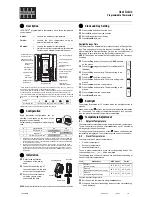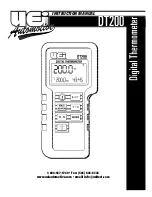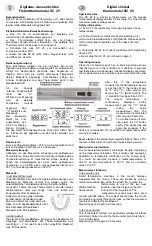
AT C 3 2 U 0 1 C o m m u n i c a t i n g , P r o g r a m m a b l e T h e r m o s t a t - I O M
R e v. : 4 F e b . , 2 0 1 3
4
G e o t h e r m a l H e a t P u m p S y s t e m s
1.0 User Menu Settings
1.1 OFFSETS
If
you
fi nd that the temperature displayed on the
thermostat does not accurately represent the room
temperature where the thermostat is located, this
offset function compensates for the difference.
The thermostat will apply an offset between what
temperature the thermostat is measuring versus the
temperature that is displayed.
1.1.1
TEMPERATURE
OFFSET
The Temperature Offset function allows for
calibration of the temperature sensor.
Adjust the Temperature Offset settings using the
up/down arrow buttons. Press the center button to
save changes.
•
Indoor Temperature (default 0°F): options:
-5°F to +5°F (in 1°F increments)
•
Remote Temperature (default 0°F): options:
-5°F to +5°F (in 1°F increments)
•
Outdoor Temperature (default 0°F): options:
-5°F to +5°F (in 1°F increments)
1.1.2
ANTICPATOR
If
you
fi nd that the thermostat is overshooting or
undershooting the temperature setpoint value, the
Anticipator setting allows for adjustment to correct
the temperature algorithm. When the Anticipator
value is set to a lower number, the thermostat
becomes more sensitive and when the Anticipator
value is raised, the thermostat becomes less
sensitive. If the thermostat is overshooting the
temperature setpoint, adjust the Anticipator
value up to reduce thermostat sensitivity. If the
thermostat is undershooting the temperature
setpoint, adjust the Anticipator value down to
increase thermostat sensitivity.
Adjust the Anticipator setting using the up/down
arrow buttons. Press the center button to save
changes.
•
Anticipator (default 3): valid range: 1 to 9
1.1.3
DIFFERENTIAL
The Differential adjustment will vary the number of
degrees from the setpoint before a call for heating
or cooling is made. Use this function if you fi nd
that the thermostat is starting a call too soon/late
or staging equipment up/down too quickly/slowly.
For example, with a 1 ˚F 1st stage differential and
a heating setpoint of 70˚F, your thermostat will not
call for heating until the temperature is 69˚F.
Adjust the Differential setting using the up/down
arrow buttons. Navigate between Differentials
using the left/right arrow buttons. Press the center
button to save changes.
•
1st Stage (default 1°F):
options: 1°F to 4°F
(in 1°F increments)
•
2nd Stage (default 1°F):
options: 1°F to 4°F
(in 1°F increments)
•
Aux Heat (default 1°F)
: options: 1°F to 4°F
(in 1°F increments)
NOTE 1:
The thermostat must be confi gured for
Multistage by installer to access the 2nd Stage
Differential setting. The thermostat must be
confi gured for Auxiliary Heat by installer to access
the Auxiliary Heat Differential setting.
NOTE
2:
The temperature control algorithm must
be confi gured for Differential control to access the
Differential settings by installer.
1.1.4
HUMIDITY
OFFSET
If
you
fi nd that the Humidity level displayed on
the thermostat does not accurately represent the
Humidity level of the room in which the thermostat
is located, use the Humidity Offset function to
calibrate the humidity sensor.
Adjust the Humidity Offset setting using the up/
down arrow buttons. Press the center button to
save changes.
•
Indoor Humidity (default 0%):
options:
-10% to +10% (in 1% increments)
1.2 CYCLES PER HOUR
The thermostat allows the user to adjust the maximum
number of on/off cycles per hour to maintain the
desired indoor temperature.
Adjust the Cycles per Hour setting using the up/
down arrow buttons. Press the center button to save
changes.
• 4 (default):
operation will start no sooner than 15
minutes after the previous call was initiated
• 6:
operation will start no sooner than 10 minutes
after the previous call was initiated (can provide
tighter temperature control)
1.3 AUTO CHANGEOVER TIME
When the thermostat is confi gured for AUTO mode,
the thermostat automatically selects heating or
cooling mode depending on the indoor temperature.
The Auto Changeover Time is the amount of time that
elapses before operation switches from heating to
cooling mode or from cooling to heating mode.
Adjust the Auto Changeover Time using the up/
down arrow buttons. Press the center button to save
changes.
• Auto Change Over Time (default 15 minutes):
options: 0 to 120 minutes (in 15 minute
increments)
Содержание ATC32U01 iGate
Страница 2: ...This page was intentionally left blank...


































